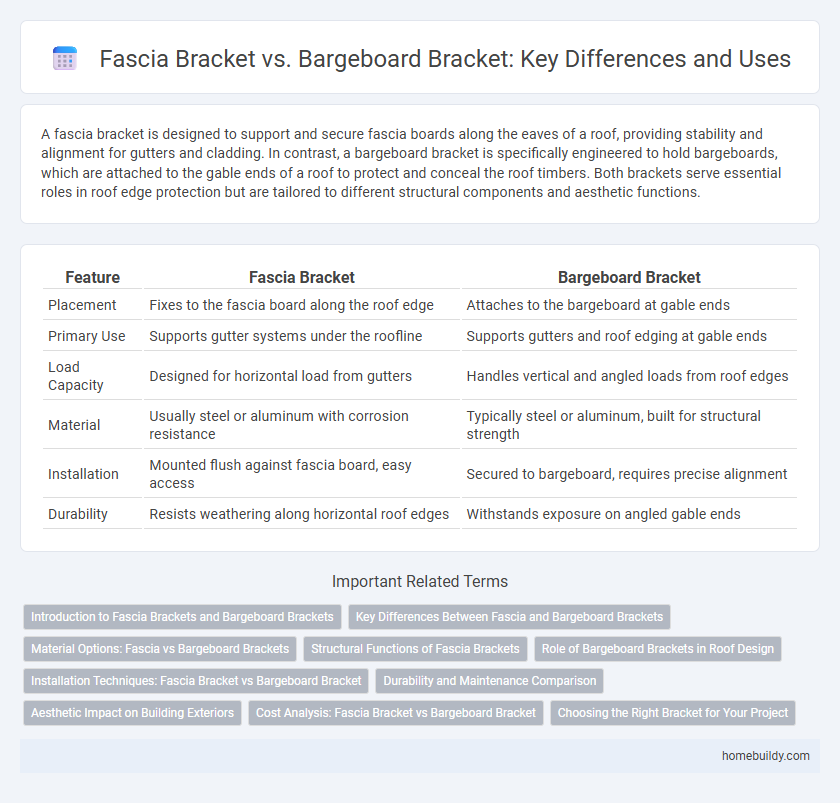A fascia bracket is designed to support and secure fascia boards along the eaves of a roof, providing stability and alignment for gutters and cladding. In contrast, a bargeboard bracket is specifically engineered to hold bargeboards, which are attached to the gable ends of a roof to protect and conceal the roof timbers. Both brackets serve essential roles in roof edge protection but are tailored to different structural components and aesthetic functions.
Table of Comparison
| Feature | Fascia Bracket | Bargeboard Bracket |
|---|---|---|
| Placement | Fixes to the fascia board along the roof edge | Attaches to the bargeboard at gable ends |
| Primary Use | Supports gutter systems under the roofline | Supports gutters and roof edging at gable ends |
| Load Capacity | Designed for horizontal load from gutters | Handles vertical and angled loads from roof edges |
| Material | Usually steel or aluminum with corrosion resistance | Typically steel or aluminum, built for structural strength |
| Installation | Mounted flush against fascia board, easy access | Secured to bargeboard, requires precise alignment |
| Durability | Resists weathering along horizontal roof edges | Withstands exposure on angled gable ends |
Introduction to Fascia Brackets and Bargeboard Brackets
Fascia brackets are designed to secure gutters directly to the fascia board, providing strong support and a clean finish for roofing drainage systems. Bargeboard brackets, on the other hand, attach gutters to the bargeboard, which is located along the gable end of a roof and often requires brackets that accommodate angled or decorative edges. Understanding the structural differences and placement of fascia versus bargeboard brackets is essential for proper gutter installation and long-term durability.
Key Differences Between Fascia and Bargeboard Brackets
Fascia brackets are designed to support the horizontal fascia boards on eaves, providing a secure attachment point for gutters and roofing elements. Bargeboard brackets, in contrast, are intended to fix bargeboards located on the gable ends of a roof, primarily protecting roof edges from weather exposure. Key differences include their positioning--fascia brackets attach along the roofline eaves while bargeboard brackets secure the sloping edges--and their functional role in enhancing structural stability and weather resistance in distinct areas of the roof.
Material Options: Fascia vs Bargeboard Brackets
Fascia brackets typically utilize materials such as galvanized steel, aluminum, and PVC, offering strong corrosion resistance and durability for long-lasting support. Bargeboard brackets are often made from heavier gauge metals like stainless steel or powder-coated steel to withstand more exposed, wind-prone edges. Material choice depends on environmental exposure and structural requirements, with fascia brackets favoring lightweight, weather-resistant composites and bargeboard brackets prioritizing enhanced strength and rigidity.
Structural Functions of Fascia Brackets
Fascia brackets provide critical support by securing the fascia board to the roof structure, ensuring stability and aligning gutters for efficient water drainage. Unlike bargeboard brackets, fascia brackets primarily handle the load from the roof edge and gutter system, preventing sagging and structural damage. Their design enhances the integrity of roofing frameworks, offering durability and resistance against environmental stresses.
Role of Bargeboard Brackets in Roof Design
Bargeboard brackets serve a critical role in roof design by securely supporting the bargeboard, which protects roof edges from weather damage and enhances aesthetic appeal. Unlike fascia brackets that primarily support the fascia board along the eaves, bargeboard brackets are specifically designed to bear the load at the roof gable ends, ensuring structural stability. Integrating bargeboard brackets correctly helps maintain roof integrity while providing a finished, decorative edge aligned with architectural style.
Installation Techniques: Fascia Bracket vs Bargeboard Bracket
Fascia brackets are installed by securing them directly to the fascia board, providing a flush and stable support for gutter systems, which requires precise alignment to ensure water flows properly. Bargeboard brackets attach to the bargeboard, typically positioned at the roof's edge, demanding careful measurement to accommodate the roof pitch and overhang. Both installation techniques require corrosion-resistant materials and proper sealing to enhance durability and prevent water infiltration in varying architectural styles.
Durability and Maintenance Comparison
Fascia brackets typically offer higher durability compared to bargeboard brackets due to their robust construction and resistance to weathering. Maintenance of fascia brackets is generally less frequent, as their design minimizes water retention and debris buildup that can cause deterioration. Bargeboard brackets, while functional, often require more regular inspection and upkeep to prevent rot and corrosion in exposed conditions.
Aesthetic Impact on Building Exteriors
Fascia brackets typically offer a sleek, low-profile design that blends seamlessly with building exteriors, enhancing modern architectural aesthetics. Bargeboard brackets, often more ornate and prominent, contribute to a traditional or decorative appearance, emphasizing roofline details. Choosing between fascia and bargeboard brackets significantly influences the visual harmony and style of the facade.
Cost Analysis: Fascia Bracket vs Bargeboard Bracket
Fascia brackets typically cost less than bargeboard brackets due to simpler design and easier installation, reducing labor expenses. Bargeboard brackets require more material and craftsmanship, increasing overall project costs. Choosing fascia brackets offers a budget-friendly solution without compromising structural integrity in most standard applications.
Choosing the Right Bracket for Your Project
Selecting the right bracket for your project depends on the structural needs and aesthetic preferences; fascia brackets are designed to support gutters or fascias directly, offering a sleek, hidden fix that enhances curb appeal. Bargeboard brackets, however, provide strong support for bargeboards at roof edges, making them ideal for projects where edge protection and decorative detailing are prioritized. Understanding the specific function and placement requirements ensures optimal durability and visual harmony in your construction or renovation work.
Fascia bracket vs Bargeboard bracket Infographic

 homebuildy.com
homebuildy.com